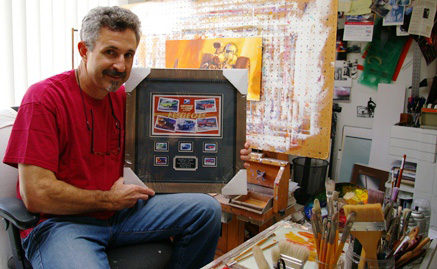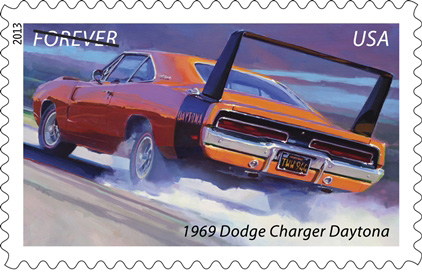Postage-stamp artist immortalizes muscle cars
Troy Anderson
Ah, muscle cars. The name evokes the aroma of burning rubber and hot motor oil, the rush of driving a fast, powerful car and a wilder, crazier time in America.
“They went fast and they were fun,” says Tom Fritz, a motor sports artist whose paintings of five iconic hot rods are featured in a new U.S. Postal Service stamp series titled “America on the Move: Muscle Cars Forever.”
 “They were wild to have on a Friday night after a football game, and you’d go cruising with your buddies. There were a lot of street drag races, too,” Fritz says.
“They were wild to have on a Friday night after a football game, and you’d go cruising with your buddies. There were a lot of street drag races, too,” Fritz says.
Although he often rode shotgun in his friend’s muscle cars in the 1970s in Southern California’s San Fernando Valley, Fritz never owned one. Unable to afford one of the high-performance cars or the costly insurance, a 16-year-old Fritz plunked down $450 for a ’56 GMC pickup – a classic that he still owns today.
But the muscle car dream that began in third grade when he first saw a ’66 Pontiac GTO through the schoolyard fence never faded.
A modern-day Rockwell
Now, at age 55, the artist once described as the “Rockwell of our generation” has captured the adventurous spirit of the muscle car era in five paintings he created for the Postal Service.
“I designed them to be very graphic,” says Fritz, who lives in the Southern California community of Newbury Park. “(Muscle cars are) a bold statement – a lot of impact, a lot of emotion.”
The limited-edition stamps feature five big-engine muscle cars that roared their way onto America’s roads in the 1960s: the ’66 Pontiac GTO, the ’67 Shelby GT-500, the ’69 Dodge Charger Daytona, the ’70 Plymouth Hemi ‘Cuda and the ’70 Chevelle SS.
And Fritz didn’t paint the cars stationary, sitting in a museum – instead, they’re on the road, burning rubber.
Putting a stamp on automotive nostalgia
The Postal Service, which selected the cars and sent pictures to Fritz, commissioned the work in 2008. Fritz, who looked at a couple of cars in the San Diego area for inspiration, completed the project in a month. Under a non-disclosure agreement, he kept his lips sealed until the stamps were unveiled in late February 2013.
The nostalgic stamps have struck a chord with the American public. After an initial print run of 60 million, the Postal Service doubled the number to 120 million to meet growing demand.
 “The muscle car stamps celebrate an exciting era in American automotive history,” seven-time NASCAR champ Richard Petty said during a dedication ceremony in February at the Daytona International Speedway. “These examples of raw power bring back fond memories for me and my family.”
“The muscle car stamps celebrate an exciting era in American automotive history,” seven-time NASCAR champ Richard Petty said during a dedication ceremony in February at the Daytona International Speedway. “These examples of raw power bring back fond memories for me and my family.”
The stamps are the third release in the “America on the Move” series. The others were “’50s Sporty Cars” in 2005 and “’50s Fins and Chrome” in 2008. Those were the work of Art Fitzpatrick, a Southern Californian best known for Pontiac Wide Track advertisements that millions of people saw in magazines worldwide from 1959 to 1971.
After creating the last stamp series, the Postal Service asked Fitzpatrick whether he wanted to do another one. Instead, Fitzpatrick recommended Fritz.
Fitzpatrick, 94, calls Fritz his “favorite car artist, besides me.”
“I think his stuff is super,” Fitzpatrick says. “The muscle cars are beautiful.”
Pumped up about muscle cars
For Fritz, one of the pre-eminent motor sports artists of his time, the interest in illuminating the relationship between man and machine began at an early age. In his childhood, Fritz would draw on anything he could get his hands on.
He developed his love of “metal making noise” after his father let him take a peek under the hood of his ’56 Chevy. Fritz was mesmerized by the “the noise, the smells and the tools.” Fritz also recalls lying on his grandmother’s living room floor, tearing Fitzpatrick’s Pontiac ads out of magazines “because I loved those illustrations.”
Although his father wanted him to be an engineer, Fritz decided to study two-dimensional art at California State University, Northridge, after doing poorly in chemistry. Upon graduation, he spent the next 25 years as a designer and illustrator at various defense contracts, including Northrop Grumman, while accepting freelance commissions on the side.
One day in the late 1980s, one of Fritz’s “old hot-rodder” neighbors showed him a box of pictures from his days racing roadsters in the Mojave Desert.
Inspired by the pictures, Fritz began painting hotrods, dragsters, muscle cars and motorcycles. Eventually, that resulted in a show at a hotrod art gallery in Detroit. The momentum built from there.
Today, Fritz’s work can be found in private and corporate collections around the world, including those of General Motors, Ford, AAA and Harley-Davidson. He produced the widely acclaimed 1998 Harley-Davidson annual report and was commissioned in 2001 to paint an image commemorating the motorcycle maker’s 100th anniversary.
Fritz’s muscle car paintings now are part of the permanent collection at the National Postal Museum in Washington, D.C.
“For me as an artist, that is like getting hit by a bolt of lightning,” Fritz says. “There are plenty of other artists that are just as qualified, if not more qualified, but they chose me to do this. I’m just honored beyond belief. I still pinch myself that I had this opportunity. It’s so cool to be the artist who’s got his artwork going around the world now.”
